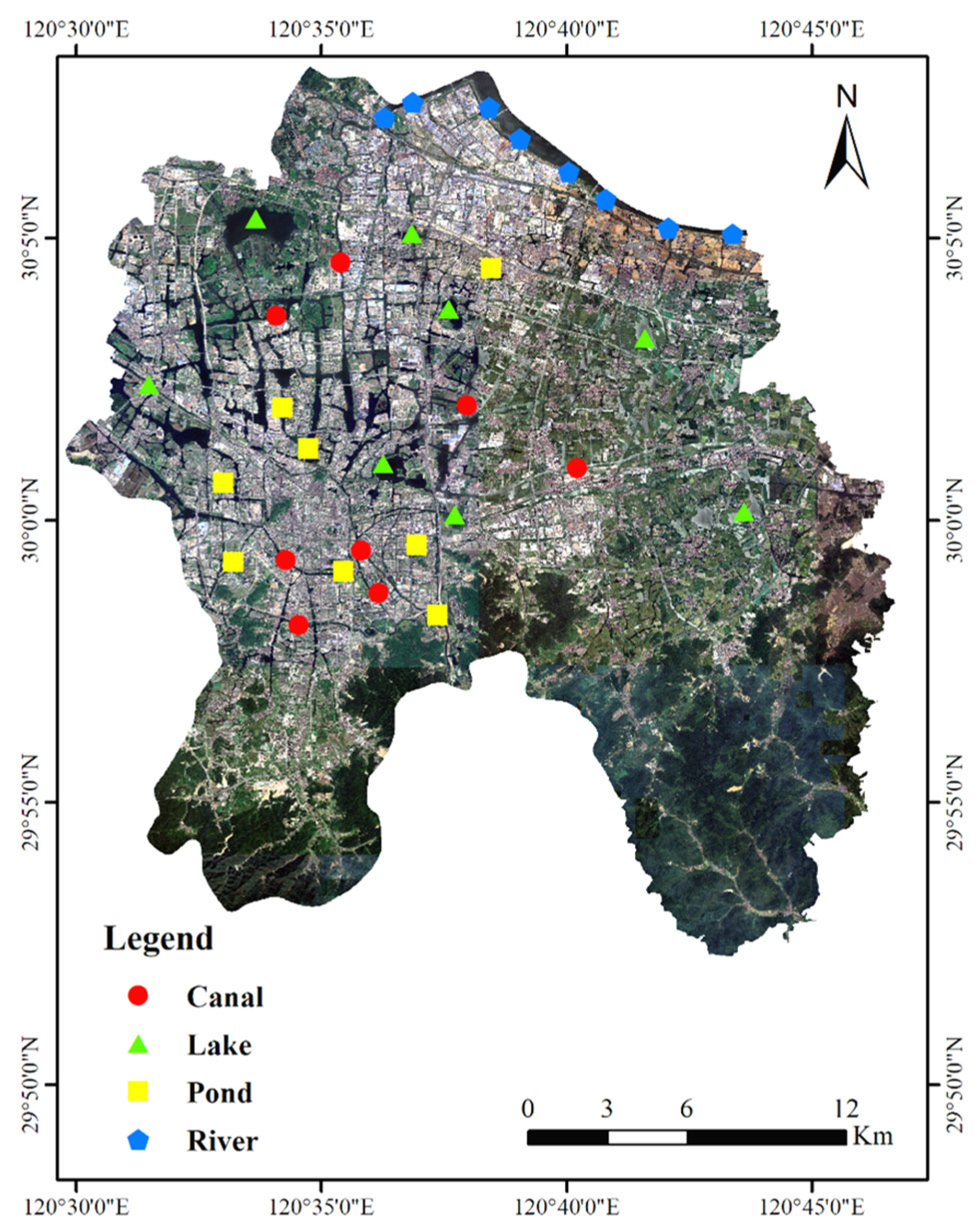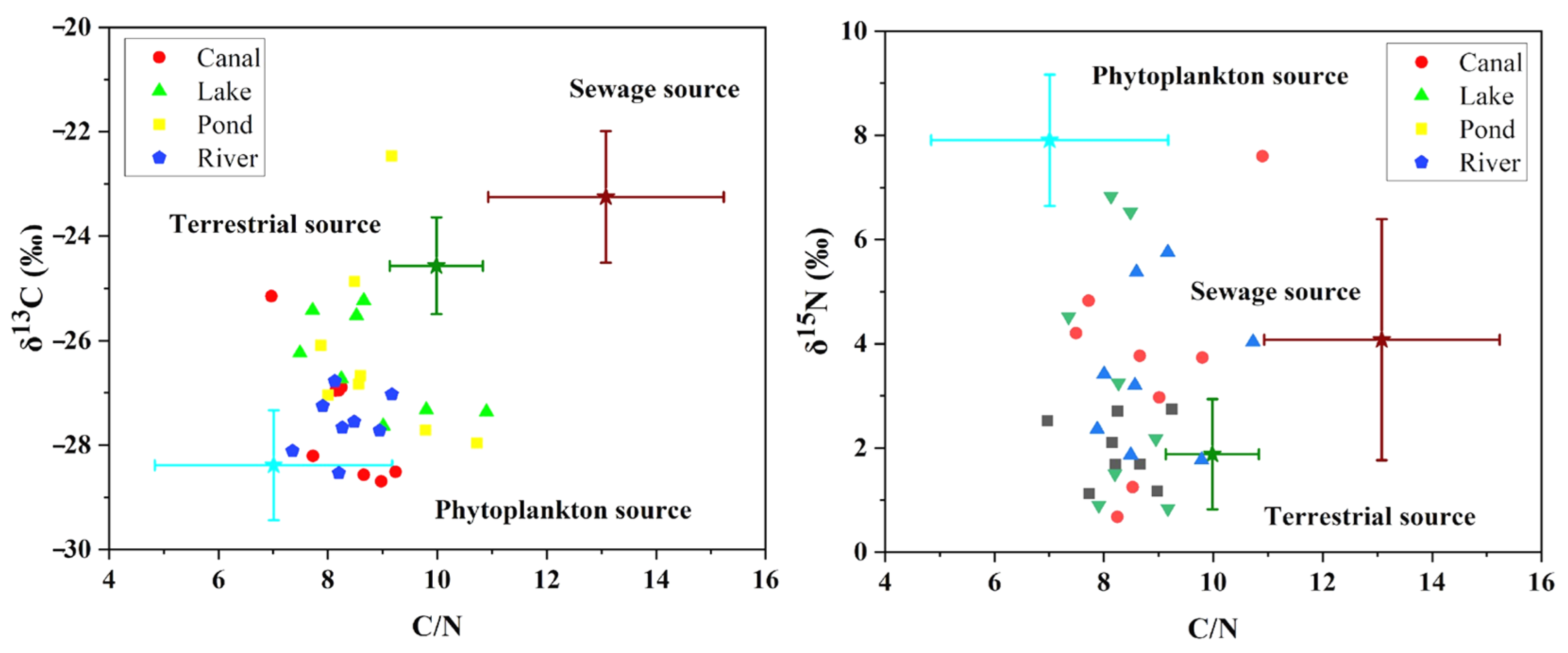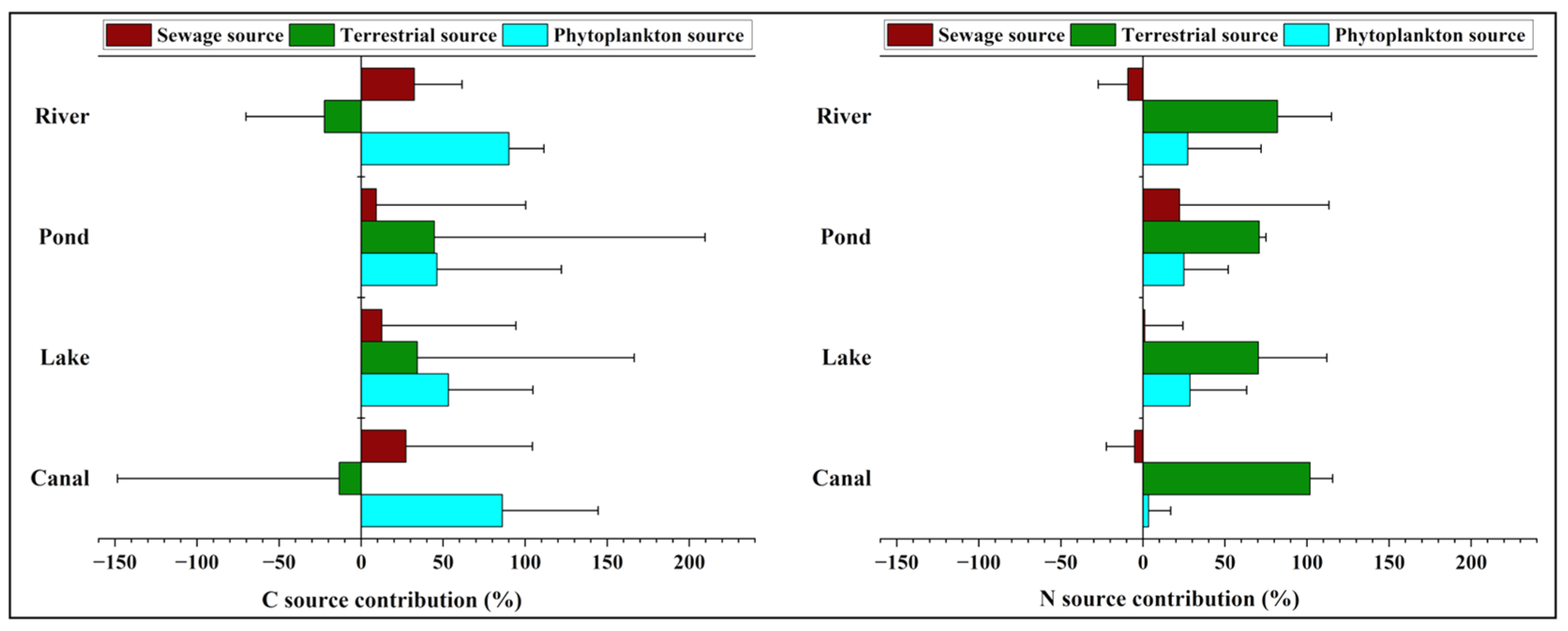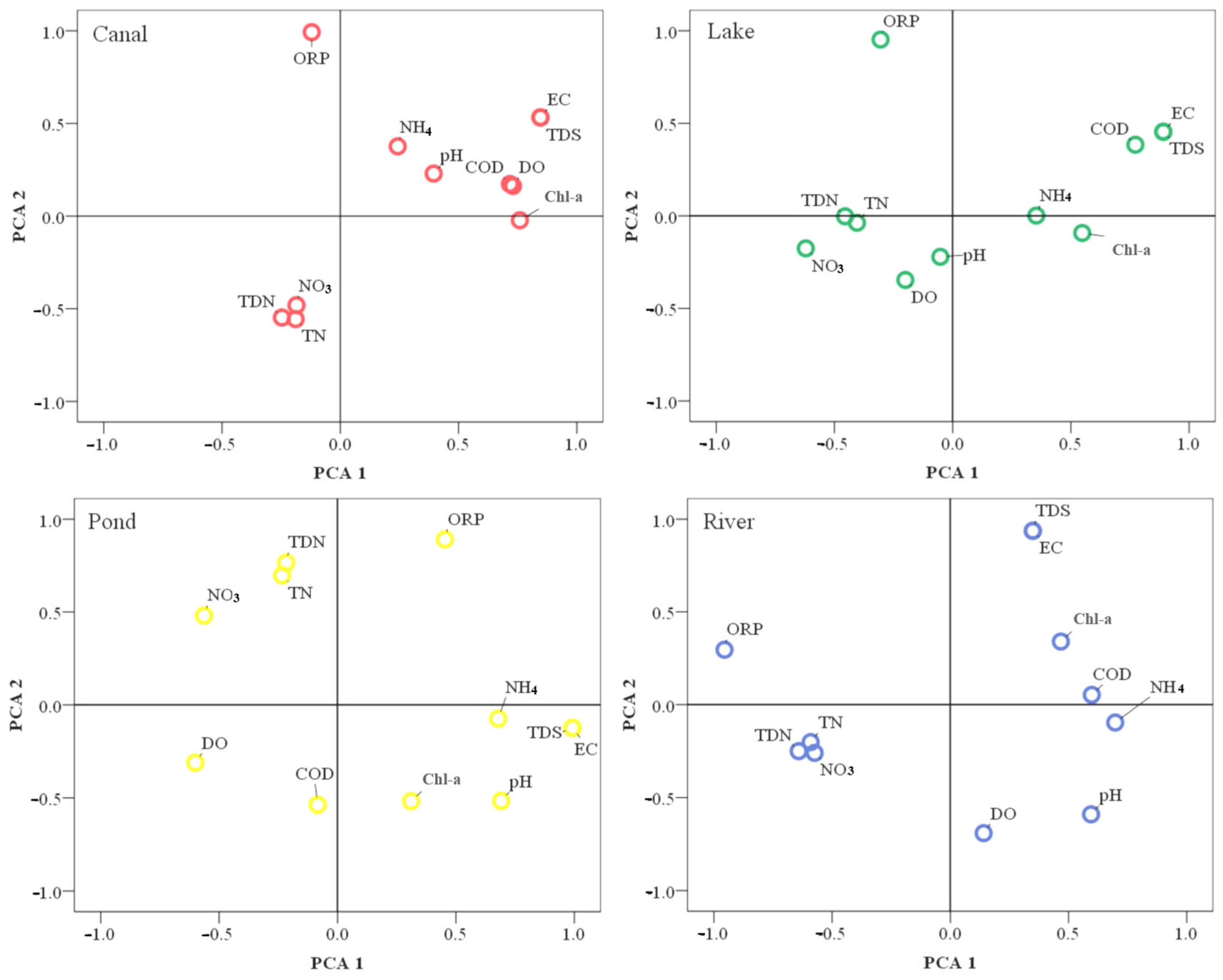Sink–Source Characteristics of Carbon and Nitrogen in Four Typical Urban Water Bodies Within a Medium-Sized City of East China
Abstract
1. Introduction
2. Materials and Methods
2.1. Study Area and Sample Collection
2.2. Quality Analysis of the Four Typical Water Body Types
2.3. C and N Content and Isotope Ratio Analysis of Sedimentary Organic Matter
3. Results
3.1. Characteristics of the Basic Water Quality Parameters for Four Typical Water Bodies
3.2. Characteristics of the Water Chemical Indicators for Four Typical Water Bodies
3.3. C and N Contents and Source Contributions of Sedimentary Organic Matter in Four Typical Water Bodies
4. Discussion
5. Conclusions
- (1)
- Urban water bodies exhibit subtle differences in water quality parameters. Artificial water bodies, particularly canals and lakes, exhibit higher DO and EC contents than natural water bodies. Canals have the highest DO contents, while lakes have the highest EC and TDS contents (1.52 times higher than those in rivers). Natural water bodies have a slightly stronger ORP and lower pH values than artificial water bodies. Overall, stationary water bodies, such as lakes and ponds, tend to have higher TDS and EC than flowing water bodies, such as rivers and canals.
- (2)
- All four urban water body types slightly exceed China’s Class-V water quality standard for TN, with Canal, Lake, Pond, and River averaging 1.29, 1.22, 1.23, and 1.23 times the standard, respectively. TD and TDN values vary significantly among the water bodies, with ponds showing the highest TDN. NH4+–N and NO3−–N levels are relatively consistent across all water bodies, except for the slightly lower NO3−–N of Lake. Chl-a and CODMn values indicate higher organic matter in Canal and Lake and lower organic matter in Pond and River, suggesting less eutrophication. These findings highlight the need for targeted water management strategies.
- (3)
- TON content in sediments is relatively uniform across all water bodies, with lakes and rivers showing slightly higher values. TOC content is highest in lakes, 1.51 times that of canals. C/N ratios vary, with ponds and lakes having the highest averages. Source quantification using isotopic analysis (δ13C and δ15N values) reveal distinct sources of organic matter: phytoplankton sources dominate in rivers and canals, whereas terrestrial sources dominate in lakes and ponds. Sewage sources contribute considerably to rivers and canals. This study underscores the importance of phytoplankton and sewage as organic matter sources in urban water bodies, highlighting the need for targeted pollution control strategies in the urban water environment.
Author Contributions
Funding
Institutional Review Board Statement
Informed Consent Statement
Data Availability Statement
Acknowledgments
Conflicts of Interest
References
- Anderson, N.J.; Dietz, R.D.; Engstrom, D.R. Land-use change, not climate, controls organic carbon burial in lakes. Proc. R. Soc. B 2013, 280, 20131278. [Google Scholar] [CrossRef] [PubMed]
- Yu, H.; Song, Y.; Chang, X.; Gao, H.; Peng, J. A scheme for a sustainable urban water environmental system during the urbanization process in China. Engineering 2018, 4, 190–193. [Google Scholar] [CrossRef]
- Nwokediegwu, Z.Q.S.; Ugwuanyi, E.D.; Dada, M.A.; Majemite, M.T.; Obaigbena, A. Urban water management: A review of sustainable practices in the USA. Eng. Sci. Technol. J. 2024, 5, 517–530. [Google Scholar] [CrossRef]
- Paerl, H.W.; Hall, N.S.; Calandrino, E.S. Controlling harmful cyanobacterial blooms in a world experiencing anthropogenic and climatic-induced change. Sci. Total Environ. 2011, 409, 1739–1745. [Google Scholar] [CrossRef]
- Jenny, J.P.; Normandeau, A.; Francus, P.; Taranu, Z.E.; Gregory-Eaves, I.; Lapointe, F.; Jautzy, J.; Ojala, A.E.K.; Dorioz, J.M.; Schimmelmann, A.; et al. Urban point sources of nutrients were the leading cause for the historical spread of hypoxia across European lakes. Proc. Natl. Acad. Sci. USA 2016, 113, 12655–12660. [Google Scholar] [CrossRef]
- Oliver, S.; Corburn, J.; Ribeiro, H. Challenges regarding water quality of eutrophic reservoirs in urban landscapes: A mapping literature review. Int. J. Environ. Res. Public Health 2018, 16, 40. [Google Scholar] [CrossRef]
- Zhang, Y.; Su, Y.; Liu, Z.; Yu, J.; Jin, M. Lipid biomarker evidence for determining the origin and distribution of organic matter in surface sediments of Lake Taihu, Eastern China. Ecol. Indic. 2017, 77, 397–408. [Google Scholar] [CrossRef]
- Liu, J.; Shen, Z.; Yan, T.; Yang, Y. Source identification and impact of landscape pattern on riverine nitrogen pollution in a typical urbanized watershed, Beijing, China. Sci. Total Environ. 2018, 628–629, 1296–1307. [Google Scholar] [CrossRef]
- Zhou, J.; Hu, M.; Liu, M.; Yuan, J.; Ni, M.; Zhou, Z.; Chen, D. Combining the multivariate statistics and dual stable isotopes methods for nitrogen source identification in coastal rivers of Hangzhou Bay, China. Environ. Sci. Pollut. Res. Int. 2022, 29, 82903–82916. [Google Scholar] [CrossRef]
- Zhou, S.; Chen, F.; Xu, Z. Evaluating the accessibility of urban parks and waterfronts through online map services: A case study of Shaoxing, China. Urban For. Urban Green. 2022, 77, 127731. [Google Scholar] [CrossRef]
- Krull, E.; Haynes, D.; Lamontagne, S.; Gell, P.; McKirdy, D.; Hancock, G.; McGowan, J.; Smernik, R. Changes in the chemistry of sedimentary organic matter within the Coorong over space and time. Biogeochemistry 2009, 92, 9–25. [Google Scholar] [CrossRef]
- Torres, I.C.; Inglett, P.W.; Brenner, M.; Kenney, W.F.; Ramesh Reddy, K. Stable isotope (δ13C and δ15N) values of sediment organic matter in subtropical lakes of different trophic status. J. Paleolimnol. 2012, 47, 693–706. [Google Scholar] [CrossRef]
- Chen, X.; Feng, M.; Ke, F.; Pan, J.; Fan, F.; Wang, Y.; Li, W. Source and biogeochemical distribution of organic matter in surface sediment in the deep oligotrophic Lake Fuxian, China. Aquat. Geochem. 2018, 24, 55–77. [Google Scholar] [CrossRef]
- Akhtar, N.; Syakir Ishak, M.I.; Bhawani, S.A.; Umar, K. Various natural and anthropogenic factors responsible for water quality degradation: A review. Water 2021, 13, 2660. [Google Scholar] [CrossRef]
- Xu, H.; Gao, Q.; Yuan, B. Analysis and identification of pollution sources of comprehensive river water quality: Evidence from two river basins in China. Ecol. Indic. 2022, 135, 108561. [Google Scholar] [CrossRef]
- Joshi, S.R.; Kukkadapu, R.K.; Burdige, D.J.; Bowden, M.E.; Sparks, D.L.; Jaisi, D.P. Organic matter remineralization predominates phosphorus cycling in the mid-bay sediments in the Chesapeake Bay. Environ. Sci. Technol. 2015, 49, 5887–5896. [Google Scholar] [CrossRef]
- Yan, D.; An, Z.; Capo, E. Organic matter content and source is associated with the depth-dependent distribution of prokaryotes in lake sediments. Freshw. Biol. 2024, 69, 496–508. [Google Scholar] [CrossRef]
- Derrien, M.; Yang, L.; Hur, J. Lipid biomarkers and spectroscopic indices for identifying organic matter sources in aquatic environments: A review. Water Res. 2017, 112, 58–71. [Google Scholar] [CrossRef]
- Li, Z.; Xu, X.; Ji, M.; Wang, G.; Han, R.; Ma, J.; Yan, X.; Liu, J. Estimating sedimentary organic matter sources by multi-combined proxies for spatial heterogeneity in a large and shallow eutrophic lake. J. Environ. Manag. 2018, 224, 147–155. [Google Scholar] [CrossRef]
- Gao, H.; Fan, Y.; Wang, G.; Li, L.; Zhang, R.; Li, S.; Wang, L.; Jiang, Z.; Zhang, Z.; Wu, J.; et al. The sources of sedimentary organic matter traced by carbon and nitrogen isotopes and environmental effects during the past 60 years in a shallow steppe lake in Northern China. Water 2023, 15, 2224. [Google Scholar] [CrossRef]
- Bergamino, L.; Dalu, T.; Richoux, N.B. Evidence of spatial and temporal changes in sources of organic matter in estuarine sediments: Stable isotope and fatty acid analyses. Hydrobiologia 2014, 732, 133–145. [Google Scholar] [CrossRef]
- Li, R.; Liang, Z.; Hou, L.; Zhang, D.; Wu, Q.; Chen, J.; Gao, L. Revealing the impacts of human activity on the aquatic environment of the Pearl River Estuary, South China, based on sedimentary nutrient records. J. Clean. Prod. 2023, 385, 135749. [Google Scholar] [CrossRef]
- Xiao, H.; Mao, C.; Wang, S.; Jia, Z.; Rao, W. Seasonal variation and provenance of organic matter in the surface sediments of the three gorges reservoir: Stable isotope analysis and implications for agricultural management. Sci. Total Environ. 2023, 870, 161886. [Google Scholar] [CrossRef] [PubMed]
- Soldatova, E.; Krasilnikov, S.; Kuzyakov, Y. Soil organic matter turnover: Global implications from δ13C and δ15N signatures. Sci. Total Environ. 2024, 912, 169423. [Google Scholar] [CrossRef]
- Carneiro, L.M.; do Rosário Zucchi, M.; de Jesus, T.B.; da Silva Júnior, J.B.; Hadlich, G.M. δ13C, δ15N and TOC/TN as indicators of the origin of organic matter in sediment samples from the estuary of a tropical river. Mar. Pollut. Bull. 2021, 172, 112857. [Google Scholar] [CrossRef]
- Zhao, R.; Dong, X.; Liu, Q.; Xu, M.; Zhao, Y. Distribution, sources and influencing factors of organic carbon in the surface sediments of the coastal tidal flats in Jiangsu Province. Front. Mar. Sci. 2023, 10, 1220923. [Google Scholar] [CrossRef]
- Zhang, J.; Hao, Q.; Li, Q.; Zhao, X.; Fu, X.; Wang, W.; He, D.; Li, Y.; Zhang, Z.; Zhang, X.; et al. Source identification of sedimentary organic carbon in coastal wetlands of the western Bohai Sea. Sci. Total Environ. 2024, 913, 169282. [Google Scholar] [CrossRef]
- Xie, S.; Yang, F.; Feng, H.; Yu, Z.; Liu, C.; Wei, C.; Liang, T. Organic fertilizer reduced carbon and nitrogen in runoff and buffered soil acidification in tea plantations: Evidence in nutrient contents and isotope fractionations. Sci. Total Environ. 2021, 762, 143059. [Google Scholar] [CrossRef]
- GB 3838-2002; Surface Water Environmental Quality Standard. Ministry of Environmental Protection of the People’s Republic of China; China Environmental Science Press: Beijing, China, 2002.
- Copeland, A.; Lytle, D.A. Measuring the oxidation–reduction potential of important oxidants in drinking water. J. Am. Water Works Assoc. 2014, 106, E10–E20. [Google Scholar] [CrossRef]
- Ganguly, S.L.; Paria, D.S.; Jana, B.B. Evaluating the ecological resilient driven performance of a tropical waste stabilization pond system using ecological signature of biological integrity. J. Ecol. Eng. 2015, 16, 97–107. [Google Scholar] [CrossRef]
- Wang, J.J.; Lafrenière, M.J.; Lamoureux, S.F.; Simpson, A.J.; Gélinas, Y.; Simpson, M.J. Differences in riverine and pond water dissolved organic matter composition and sources in Canadian high Arctic watersheds affected by active layer detachments. Environ. Sci. Technol. 2018, 52, 1062–1071. [Google Scholar] [CrossRef] [PubMed]
- Zhang, W.S.; Swaney, D.P.; Li, X.Y.; Hong, B.; Howarth, R.W.; Ding, S.H. Anthropogenic point-source and non-point-source nitrogen inputs into Huai River basin and their impacts on riverine ammonia–nitrogen flux. Biogeosciences 2015, 12, 4275–4289. [Google Scholar] [CrossRef]
- Choi, M.; Lee, C.; Kim, L.H.; Choi, S.H.; Bong, Y.S.; Lee, K.S.; Shin, W.J. Assessing sources of nutrients in small watersheds with different land-use patterns using TN, TP, and NO3--N. J. Hydrol. Reg. Stud. 2024, 55, 101958. [Google Scholar] [CrossRef]
- Zou, W.; Zhu, G.; Cai, Y.; Vilmi, A.; Xu, H.; Zhu, M.; Gong, Z.; Zhang, Y.; Qin, B. Relationships between nutrient, chlorophyll a and Secchi depth in lakes of the Chinese Eastern Plains ecoregion: Implications for eutrophication management. J. Environ. Manag. 2020, 260, 109923. [Google Scholar] [CrossRef]
- Zhang, Z.; Zhang, F.; Du, J.; Chen, D.; Zhang, W. Impacts of land use at multiple buffer scales on seasonal water quality in a reticular river network area. PLoS ONE 2021, 16, e0244606. [Google Scholar] [CrossRef]
- Kayler, Z.E.; Premke, K.; Gessler, A.; Gessner, M.O.; Griebler, C.; Hilt, S.; Klemedtsson, L.; Kuzyakov, Y.; Reichstein, M.; Siemens, J.; et al. Integrating aquatic and terrestrial perspectives to improve insights into organic matter cycling at the landscape scale. Front. Earth Sci. 2019, 7, 127. [Google Scholar] [CrossRef]
- Rantala, M.V.; Nevalainen, L.; Rautio, M.; Galkin, A.; Luoto, T.P. Sources and controls of organic carbon in lakes across the subarctic treeline. Biogeochemistry 2016, 129, 235–253. [Google Scholar] [CrossRef]
- Ke, Z.; Tan, Y.; Huang, L.; Zhao, C.; Jiang, X. Spatial distributions of δ13C, δ15N and C/N ratios in suspended particulate organic matter of a bay under serious anthropogenic influences: Daya Bay, China. Mar. Pollut. Bull. 2017, 114, 183–191. [Google Scholar] [CrossRef]
- Liu, Y.; Wang, X.; Wen, Q.; Zhu, N. Identifying sources and variations of organic matter in an urban river in Beijing, China using stable isotope analysis. Ecol. Indic. 2019, 102, 783–790. [Google Scholar] [CrossRef]
- Dalu, T.; Richoux, N.B.; Froneman, P.W. Nature and source of suspended particulate matter and detritus along an austral temperate river–estuary continuum, assessed using stable isotope analysis. Hydrobiologia 2016, 767, 95–110. [Google Scholar] [CrossRef]
- Cai, M.; Lin, Y.; Chen, M.; Yang, W.; Du, H.; Xu, Y.; Cheng, S.; Xu, F.; Hong, J.; Chen, M.; et al. Improved source apportionment of PAHs and Pb by integrating Pb stable isotopes and positive matrix factorization application (PAHs): A historical record case study from the northern South China Sea. Sci. Total Environ. 2017, 609, 577–586. [Google Scholar] [CrossRef]
- Xiao, H.Y.; Liu, C.Q. Identifying organic matter provenance in sediments using isotopic ratios in an urban river. Geochem. J. 2010, 44, 181–187. [Google Scholar] [CrossRef]
- Blake, W.H.; Boeckx, P.; Stock, B.C.; Smith, H.G.; Bodé, S.; Upadhayay, H.R.; Gaspar, L.; Goddard, R.; Lennard, A.T.; Lizaga, I.; et al. A deconvolutional Bayesian mixing model approach for river basin sediment source apportionment. Sci. Rep. 2018, 8, 13073. [Google Scholar] [CrossRef]
- Liu, J.; Han, G. Tracing Riverine particulate black carbon sources in Xijiang river Basin: Insight from stable isotopic composition and Bayesian mixing model. Water Res. 2021, 194, 116932. [Google Scholar] [CrossRef]




| Water Quality Parameters | pH | ORP (REDOX) | DO (mg/L) | EC (uS/cm) | TDS (mg/L) | |
|---|---|---|---|---|---|---|
| Canal (n = 8) | Range | 7.45–9.96 | 121.52–184.66 | 4.06–11.25 | 123.00–209.67 | 79.60–135.67 |
| Mean | 8.84 | 159.77 | 8.83 | 174.05 | 112.68 | |
| SD | 0.8 | 24.56 | 2.84 | 26.59 | 17.23 | |
| Lake (n = 8) | Range | 7.95–9.96 | 94.52–201.34 | 4.36–9.21 | 117.86–462.20 | 76.14–299.80 |
| Mean | 8.87 | 167.78 | 7.41 | 224.59 | 145.56 | |
| SD | 0.9 | 32.89 | 1.67 | 104.15 | 67.62 | |
| Pond (n = 8) | Range | 7.00–9.37 | 73.66–214.26 | 4.78–10.17 | 147.00–231.40 | 94.88–150.00 |
| Mean | 8.65 | 182.96 | 6.94 | 194.18 | 125.75 | |
| SD | 0.72 | 46.55 | 2.32 | 30.96 | 20.18 | |
| River (n = 8) | Range | 7.82–9.72 | 160.70–212.75 | 2.84–13.29 | 97.60–230.00 | 62.80–149.14 |
| Mean | 8.47 | 185.94 | 8.04 | 148.13 | 95.83 | |
| SD | 0.59 | 16.88 | 3.67 | 48.07 | 31.31 | |
| Water Chemical Indicators | TN (mg/L) | TDN (mg/L) | NH4-N (mg/L) | NO3-N (mg/L) | Chl-a (ug/L) | CODMn (mg/L) | |
|---|---|---|---|---|---|---|---|
| Canal (n = 8) | Range | 2.21–3.06 | 2.10–2.84 | 0.06–0.12 | 1.31–2.54 | 2.35–11.19 | 2.88–3.96 |
| Mean | 2.58 | 2.42 | 0.09 | 1.81 | 5.42 | 3.41 | |
| SD | 0.37 | 0.31 | 0.02 | 0.5 | 3.53 | 0.35 | |
| Lake (n = 8) | Range | 1.89–2.93 | 1.81–2.76 | 0.06–0.13 | 1.03–2.18 | 1.51–6.23 | 2.67–5.25 |
| Mean | 2.44 | 2.31 | 0.1 | 1.64 | 4.35 | 3.47 | |
| SD | 0.37 | 0.38 | 0.03 | 0.4 | 1.8 | 0.8 | |
| Pond (n = 8) | Range | 2.31–2.75 | 2.18–2.71 | 0.05–0.18 | 1.52–2.22 | 2.13–5.08 | 2.88–3.58 |
| Mean | 2.55 | 2.46 | 0.1 | 1.8 | 3.68 | 3.29 | |
| SD | 0.17 | 0.19 | 0.05 | 0.23 | 1.14 | 0.24 | |
| River (n = 8) | Range | 1.67–3.35 | 1.60–3.15 | 0.03–0.14 | 0.99–2.51 | 1.10–5.45 | 2.08–4.25 |
| Mean | 2.46 | 2.28 | 0.07 | 1.76 | 3.37 | 3.09 | |
| SD | 0.6 | 0.55 | 0.04 | 0.57 | 1.79 | 0.76 | |
| C and N Contents of Sedimentary Organic Matter | TON (%) | TOC (%) | C/N | |
|---|---|---|---|---|
| Canal (n = 8) | Range | 0.14–0.36 | 1.17–3.36 | 6.96–9.24 |
| Mean | 0.23 | 2.00 | 8.27 | |
| SD | 0.09 | 0.85 | 0.72 | |
| Lake (n = 8) | Range | 0.10–0.43 | 0.81–4.65 | 7.49–10.90 |
| Mean | 0.29 | 3.01 | 8.79 | |
| SD | 0.12 | 1.32 | 1.12 | |
| Pond (n = 8) | Range | 0.16–0.34 | 1.34–3.54 | 7.87–10.72 |
| Mean | 0.25 | 2.20 | 8.90 | |
| SD | 0.08 | 0.80 | 0.96 | |
| River (n = 8) | Range | 0.14–0.43 | 1.09–4.01 | 7.35–9.16 |
| Mean | 0.29 | 2.52 | 8.30 | |
| SD | 0.12 | 1.10 | 0.57 | |
Disclaimer/Publisher’s Note: The statements, opinions and data contained in all publications are solely those of the individual author(s) and contributor(s) and not of MDPI and/or the editor(s). MDPI and/or the editor(s) disclaim responsibility for any injury to people or property resulting from any ideas, methods, instructions or products referred to in the content. |
© 2025 by the authors. Licensee MDPI, Basel, Switzerland. This article is an open access article distributed under the terms and conditions of the Creative Commons Attribution (CC BY) license (https://creativecommons.org/licenses/by/4.0/).
Share and Cite
Xie, S.; Yang, S.; Deng, Y.; Xu, H.; Zhou, Y.; Liu, S.; Zhou, H.; Yang, F.; Wei, C. Sink–Source Characteristics of Carbon and Nitrogen in Four Typical Urban Water Bodies Within a Medium-Sized City of East China. Appl. Sci. 2025, 15, 1434. https://doi.org/10.3390/app15031434
Xie S, Yang S, Deng Y, Xu H, Zhou Y, Liu S, Zhou H, Yang F, Wei C. Sink–Source Characteristics of Carbon and Nitrogen in Four Typical Urban Water Bodies Within a Medium-Sized City of East China. Applied Sciences. 2025; 15(3):1434. https://doi.org/10.3390/app15031434
Chicago/Turabian StyleXie, Shaowen, Shengnan Yang, Yanghui Deng, Haofan Xu, Yanbo Zhou, Shujuan Liu, Hongyi Zhou, Fen Yang, and Chaoyang Wei. 2025. "Sink–Source Characteristics of Carbon and Nitrogen in Four Typical Urban Water Bodies Within a Medium-Sized City of East China" Applied Sciences 15, no. 3: 1434. https://doi.org/10.3390/app15031434
APA StyleXie, S., Yang, S., Deng, Y., Xu, H., Zhou, Y., Liu, S., Zhou, H., Yang, F., & Wei, C. (2025). Sink–Source Characteristics of Carbon and Nitrogen in Four Typical Urban Water Bodies Within a Medium-Sized City of East China. Applied Sciences, 15(3), 1434. https://doi.org/10.3390/app15031434







